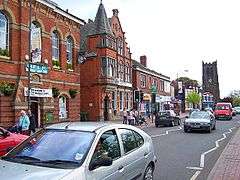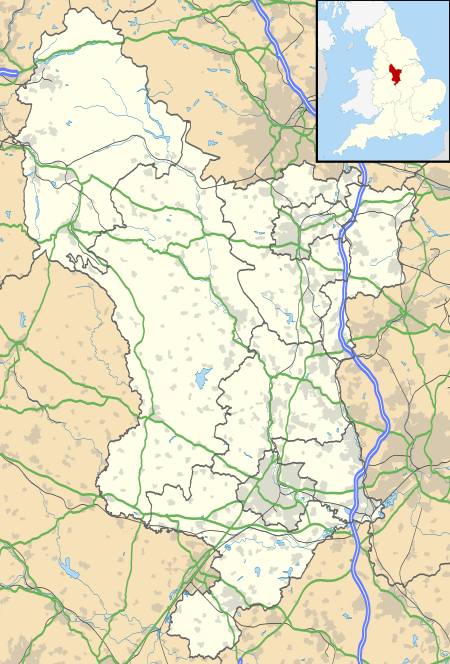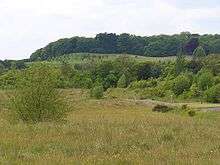Heanor
Heanor ( /ˈhiːnə/) is a town in the Amber Valley district of Derbyshire in the East Midlands of England. It lies 8 miles (13 km) north-east of Derby, and forms with the adjacent village of Loscoe the civil parish and town council-administered area of Heanor and Loscoe, which had a population of 17,251 in the 2011 census.
| Heanor | |
|---|---|
 Heanor Town Hall (left), with St Lawrence's Church (right) | |
 Heanor Location within Derbyshire | |
| Population | 17,251 Whole administrative parish (2011 census)[1] |
| OS grid reference | SK 43334 46528 |
| Civil parish |
|
| District | |
| Shire county | |
| Region | |
| Country | England |
| Sovereign state | United Kingdom |
| Post town | HEANOR |
| Postcode district | DE75 |
| Dialling code | 01773 |
| Police | Derbyshire |
| Fire | Derbyshire |
| Ambulance | East Midlands |
| UK Parliament | |
History
The name Heanor derives from the Old English hēan (the dative form of hēah) and ofer, and means "[place at] the high ridge". In the Domesday Book of 1086 it was recorded as Hainoure,[2] with its entry stating:
6M In CODNOR and Heanor and Langley [in Heanor] and 'Smithycote' [in Codnor Park] 8 thegns had 7 carucates of land to the geld [before 1066]. [There is] land for as many ploughs. There are now 3 ploughs in demesne, and 11 villains and 2 bordars and 3 sokemen having 5½ ploughs. There is a church and 1 mill [rendering] 12d and 35 acres (140,000 m2) of meadow [and] woodland pasture 2 leagues long and 3 furlongs broad. TRE[3] worth £4 sterling; now 41s 4d [£2.2] per year. Warner holds it.[4]
Samuel Lewis's A Topographical Dictionary of England, published in 1848, states that Heanor parish "abounds with coal and ironstone, both worked extensively, the collieries alone affording employment to more than 2000 persons. The town is pleasantly situated upon an eminence, on the road from Derby to Mansfield. The principal articles of manufacture are silk and cotton goods, hosiery, and bobbinet lace, providing occupation to about 800 persons." The parish then covered 7,000 acres (2,800 ha) and was in the union of Basford and the hundred of Morleston and Litchurch, with Heanor town itself covering 1,500 acres (610 ha) with 3,058 inhabitants. The parish church, dedicated to St Mary, was "a very ancient edifice, with a lofty substantial tower, from which is an extensive view," though the dictionary noted there were also "places of worship for Baptists, Independents, Wesleyans, and Ranters".[5] In 1867 the church building was replaced, retaining the 15th-century tower. It is possible the dedication was changed to St Lawrence at that time.
Heanor Market Place developed in the 1890s after the break-up of the Heanor Hall estate by the Miller Mundy family of nearby Shipley Hall. The Market Place site had been part of Heanor Hall Park and the main focus of trading activity hitherto Tag Hill.[6]
Governance
Civic history
The parish of Heanor formed a local board of health in about 1850 to provide services in the town. In 1895, under the Local Government Act 1894, the board's area became an urban district. In 1899 Heanor Urban District was enlarged by the neighbouring parish of Codnor and Loscoe.[7][8] The urban district remained until 1974, when it became part of a new non-metropolitan district of Amber Valley under the Local Government Act 1972.[9] Heanor Urban District had been an unparished area,[9] but in 1984 three new civil parishes were created in Amber Valley, Heanor being within the civil parish of Heanor and Loscoe the other two parishes Aldercar and Langley Mill and Codnor). In 1987 Heanor and Loscoe Parish Council resolved to designate the parish a town,[n 1] and so it is now governed by a town council headed by a town mayor.[10]
Current
Since 1984 Heanor has had three tiers of local government: Derbyshire County Council at county level, Amber Valley Borough Council at district level, and Heanor and Loscoe Town Council at parish level. Heanor falls into two single-member electoral divisions of the County Council, Greater Heanor and Heanor Central. Since the 2017 Derbyshire County Council election, both divisions are represented by members of the Conservative Party.[11]
For Amber Valley Borough Council, Heanor and Loscoe civil parish divides into three electoral wards – Heanor East, Heanor West, and Heanor and Loscoe – which each elect two councillors. From 2014 to 2018, all six were from Labour, until the Conservatives narrowly took one seat in both Heanor East and Heanor West at the 2018 local elections, but fell short of taking a seat in Heanor and Loscoe.[12] In the May 2019 local elections, Labour won 13 seats on the Town Council and the Conservatives 8.[13]
Geography
Measured directly, Heanor town is 8 miles (13 km) north-east of Derby and 9.5 miles (15.3 km) west-north-west of Nottingham.[14][15] It stands on a hill between 65 metres (213 ft) and 125 metres (410 ft) above sea-level.[16] It lies within the Nottinghamshire, Derbyshire and Yorkshire Coalfield National Character Area as defined by Natural England.[17]
Heanor and Loscoe civil parish includes all Heanor town except Heanor Gate Science College and a few surrounding streets on the western edge of town (near the road to Smalley), Heanor Gate Industrial Estate to the south west, and a small area of houses on the town's south-eastern fringe near the main road to Ilkeston. The college and surrounding streets and half the industrial estate are in Smalley civil parish, the other areas in Shipley civil parish.[16]
Heanor and Loscoe civil parish contains no conservation areas, but 30 per cent of the area lies in a green belt. The one nature reserve and four wildlife sites are all of local significance.[18]
Economy
The most important economic sector in the town, employing more than 20 per cent of the working population, is manufacturing, with the retail sector employing over 17 per cent. Coal mining and textiles used to be major industries, but both declined. In December 2013 the unemployment rate was 2.3 per cent in Heanor East and Heanor and Loscoe wards and 3.5 per cent in Heanor West ward. The average for England at the time was 2.8 per cent.[18]
The Matthew Walker factory in Heanor Gate Industrial Park, famous for the production of Christmas puddings, was sold in 1992 to the Northern Foods Group. Other companies on the park include Advanced Composites Group, Cullum Detuners Ltd and Isolated Systems Ltd. In 2011 the 2 Sisters Food Group purchased Northern Foods. The Matthew Walker factory is now a part of the 2 Sisters Chilled Division.
Retail chains with a presence in the town include Tesco,[18] Aldi,[19] and Boyes.[20] A small outdoor market is held on Fridays and Saturdays.[21]
Heanor merges into Langley Mill.
Demography
In the 2011 census Heanor and Loscoe civil parish had 7,512 dwellings,[22] 7,221 households and a population of 17,251.[1] 18.7 per cent of residents were under the age of 16 (compared to 18.9 per cent for England as a whole) and 16.5 per cent of residents were aged 65 or over (compared to 16.4 per cent for England as a whole).[23] Like the Amber Valley as a whole, the population was found to be ethnically less diverse than the average for England; 1.84 per cent of residents were of non-white ethnicity (England: 14.58 per cent).[24] Christianity was the most prevalent stated religious affiliation (56.4 per cent; England: 59.4 per cent); 35.6 per cent stated they had no religion (England: 24.7 per cent).[25]
Education
Heanor has two infant schools (Corfield Church of England Infant School and Marlpool Infant School), three primary schools (Coppice Primary School, Howitt Primary Community School and Loscoe Church of England Primary School), two junior schools (Marlpool Junior School and Mundy Church of England Voluntary Controlled Junior School) and one secondary school (Heanor Gate Science College).[18] Heanor Grammar School, which was just to the east of the market place, was latterly part of Derby College but is now closed down. A book on the history of the school was published in 2008.[26]
Sport and leisure

Shipley Country Park, a steep wooded knoll bordering the south and west of the town, has a riding school and three lakes surrounding it. The park consists of most of the former estate of the Miller-Mundy family, which until the 1920s held Shipley Hall (demolished in the 1940s). It was then sold for intensive open-cast and deep-seam mining by what became the National Coal Board, before being restored and handed to the county council in the 1970s.
The local association football team is Heanor Town Football Club (the Lions). Established in 1883, the club belongs to the Northern Counties East League Premier Division. Its youth team is called Heanor Juniors. Famous ex-players include Nigel Clough, who went on to play for Nottingham Forest, Liverpool and Manchester City and now manages Burton Albion,[27] and Nigel Pearson, who captained Sheffield Wednesday to a League Cup win over Manchester United at Wembley and is currently manager at Watford. The club shares grounds with Heanor Town Cricket Club.
Heanor Clarion Cycling Club was founded in 1934.[28]
Transport
The nearest station to Heanor is two miles away at Langley Mill, which has services to Nottingham, Sheffield and beyond. Earlier the Midland Railway had a line between Shipley Gate and Butterley that passed through Heanor, but it was closed to passengers in 1926. The Great Northern Railway had a branch line that terminated in a goods yard and small station in Heanor. Thi was closed in 1928, though temporarily reopened in 1939.
Bus routes link Heanor Nottingham, Derby, Mansfield and other towns and cities in the area. The operators include Trent Barton and Yourbus
The nearest international airport is East Midlands Airport (18 miles, 29 km).
Media
The district newspaper is the Ripley and Heanor News, which appears each Thursday.[29]
Notable residents
- Billy Bestwick (1875–1938), cricketer, was born in Heanor.
- George William Bissill (1896–1973), painter, grew up in Langley Mill and attended school in Heanor.[30]
- Sir Richard William Barnes Clarke (1910–1975), journalist and civil servant, was born in Heanor.[31]
- Henry Garnet (1555–1606), Jesuit, born in Heanor, was executed for involvement in the Gunpowder Plot.[32]
- William Gregg (1890–1969), born and died in Heanor, was awarded the Victoria Cross for bravery in 1918.[33]
- The Howitt brothers: William Howitt (1792–1879), author,[34] Richard, poet (1799–1869) and Godfrey, entomologist, (1800–1873) were born in Heanor.
- Mary Howitt (1799–1888), author, lived in Heanor.
- Douglas Keen (27 October 1913 – 6 November 2008), designer of Ladybird Books, lived in Heanor and created the first title in the kitchen of his house there.[35][36]
- Samuel Roper (died 1658), antiquary, was born in Heanor.[37]
- Edward Smith (1819–1874), physician, medical writer and dietician, was born in Heanor.[38]
- John Varley (1740–1809), canal engineer, supervised construction of the Chesterfield Canal, was born in Heanor.
- Samuel Watson (c. 1662–1715), sculptor, was born in Heanor.[39]
Notable buildings
There are ten structures in Heanor and Loscoe civil parish listed by Historic England as of particular architectural or historical interest: two in Loscoe and eight in Heanor. The Church of St Lawrence in Heanor is listed as Grade II*. The other nine are listed as Grade II.[40] St Lawrence's has 15th-century origins, but was altered in 1866–1868 and about 1980.[41]
Notes and references
- Notes
- Under section 245 of the 1972 Act
- References
- "Area: Heanor and Loscoe (Parish). Key Figures for 2011 Census: Key Statistics". Neighbourhood Statistics. Office for National Statistics. Retrieved 6 April 2016.
- David Mills, ed. (2011) [1991]. A Dictionary of British Place Names. Oxford University Press. ISBN 0-19-852758-6.
- in Latin Tempore Regis Edwardi – in the time of King Edward before the Battle of Hastings.
- Domesday Map Archived 17 July 2013 at Archive.today Retrieved 2013-07-16.
- Samuel Lewis, ed. (1848). A Topographical Dictionary of England. British History Online. pp. 456–459. Retrieved 9 April 2016.
- "Heanor Market Place". Heanor & District Local History Society. Retrieved 18 April 2016.
- "Heanor". Kelly's Directory of Derbyshire. Historical Directories. 1912. p. 296. Retrieved 1 June 2010.
- Youngs, Frederic A, Jr. (1991). Guide to the Local Administrative Units of England, Vol.2: Northern England. London: Royal Historical Society. p. 77. ISBN 0-86193-127-0.
- Local government in England and Wales: A Guide to the New System. London: HMSO. 1974. p. 40. ISBN 0-11-750847-0.
- Town Council site. Retrieved 7 April 2020.
- "Councillors". Derbyshire County Council. Retrieved 16 June 2010.
- 2018 borough election results Retrieved 7 April 2020.
- 2019 local elections Retrieved 7 April 2020.
- Ordnance Survey (2001), 1:50,000 Landranger Series, Sheet 128 (Derby & Burton upon Trent), ISBN 0-319-22540-2
- Ordnance Survey (1996), 1:50,000 Landranger Series, Sheet 129 (Nottingham & Loughborough area), ISBN 0-319-22129-6
- Ordnance Survey (2000), 1:25,000 Explorer Series, Sheet 260 (Nottingham, Vale of Belvoir), ISBN 0-319-21896-1
- "NCA Profile: 38. Nottinghamshire, Derbyshire and Yorkshire Coalfield (NE402)". Natural England. 31 January 2013. Retrieved 11 April 2016.
- "Area Profile: Heanor". Amber Valley Borough Council. Retrieved 14 April 2016.
- "ALDI - High Street". Aldi Stores Limited. Retrieved 17 April 2016.
- https://www.ripleyandheanornews.co.uk/news/new-high-street-store-set-to-bring-25-jobs-to-heanor-town-centre-1-6973565
- "Heanor – Up and Coming Market Town – Love Heanor". visitambervalley.com. Amber Valley Borough Council. 2012. Retrieved 12 April 2016.
- "Area: Heanor and Loscoe (Parish). Dwellings, Household Spaces and Accommodation Type, 2011 (KS401EW)". Neighbourhood Statistics. Office for National Statistics. Retrieved 6 April 2016.
- "Area: Heanor and Loscoe (Parish). Age Structure, 2011 (KS102EW)". Neighbourhood Statistics. Office for National Statistics. Retrieved 6 April 2016.
- "Area: Heanor and Loscoe (Parish). Ethnic Group, 2011 (KS201EW)". Neighbourhood Statistics. Office for National Statistics. 30 January 2013. Retrieved 14 April 2016.
- "Area: Heanor and Loscoe (Parish). Religion, 2011 (KS209EW)". Neighbourhood Statistics. Office for National Statistics. 30 January 2013. Retrieved 17 April 2016.
- Follow the Master. Heanorhistory.org.uk. Retrieved on 5 May 2013.
- Clough takes over as Derby boss, BBC Sport, 6 January 2009.
- Heanor Clarion Cycling Club Retrieved June 2007
- Retrieved 7 April 2020.
- Seddon, Peter (20 October 2015). "George Bissill - Derbyshire's forgotten 'Pitman Painter'". Derbyshire Life Magazine. Archant Community Media Ltd. Retrieved 17 April 2016.
- Goldman, Samuel (September 2004). "Clarke, Sir Richard William Barnes (1910–1975)". Oxford Dictionary of National Biography. Oxford: Oxford University Press. doi:10.1093/ref:odnb/30938. Retrieved 4 June 2010.
- Mee, Arthur (1969). Derbyshire. The King's England. Hodder and Stoughton. p. 131.
- GRAVE LOCATION FOR HOLDERS OF THE VICTORIA CROSS IN THE COUNTY OF : DERBYSHIRE Archived 17 July 2007 at the Wayback Machine. Victoriacross.org.uk. Retrieved on 5 May 2013.
- William Howitt. The Notable Names Database (NNDB).
- Connolly, Cressida (29 November 2008) Obituary: Douglas Keen, The Guardian.
- Hawley, Zena (14 January 2013) How Douglas's little Ladybird books had a big impact on our education. This is Derbyshire. Retrieved on 5 May 2013.
- British History academic site accessed 7 October 2007
- Carpenter, Kenneth J (September 2004). "Smith, Edward (1819–1874)". Oxford Dictionary of National Biography. Oxford: Oxford University Press. doi:10.1093/ref:odnb/25794. Retrieved 4 June 2010.
- Brighton, Trevor (September 2004). "Watson, Samuel (bap. 1662, d. 1715)". Oxford Dictionary of National Biography. Oxford: Oxford University Press. doi:10.1093/ref:odnb/28864. Retrieved 4 June 2010.
- "Listed Buildings in Heanor and Loscoe, Derbyshire, England". britishlistedbuildings.co.uk. Retrieved 4 April 2016.
- "Church of St Lawrence, Heanor and Loscoe". britishlistedbuildings.co.uk. Retrieved 10 April 2016.
External links
| Wikimedia Commons has media related to Heanor. |